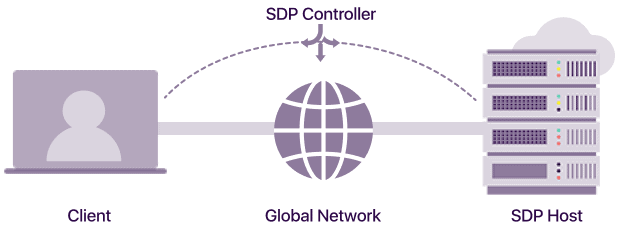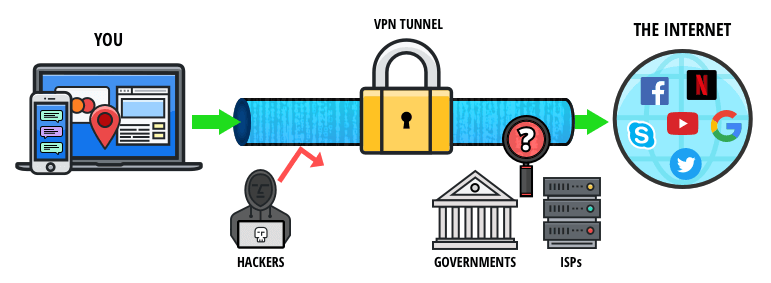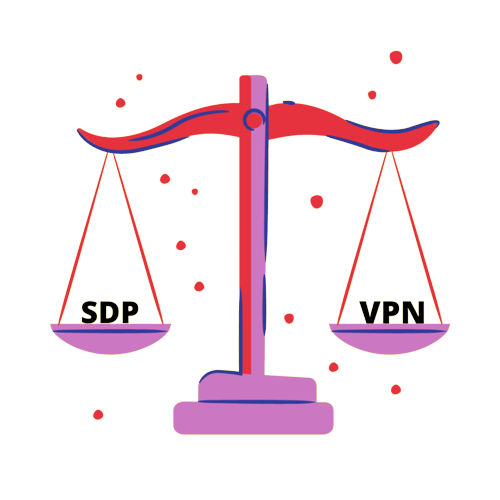Introduction to SDP and VPN
Welcome to the world of secure connectivity! In today’s digital landscape, where data breaches and cyber threats are lurking around every corner, ensuring robust protection for your network is paramount, this is why we’re going to talk about sdp vs. vpn. That’s where technologies like SDP (Software-Defined Perimeter) and VPN (Virtual Private Network) come into play. These two solutions have revolutionized the way we connect remotely, providing enhanced security and privacy.
But what exactly are SDP and VPN? How do they differ from each other? And which one is right for you? In this blog post, we’ll dive deep into the world of SDP vs. VPN, unraveling their differences, similarities, advantages, and helping you choose the perfect solution to safeguard your online activities.
So fasten your seatbelts as we embark on this exciting journey to explore the fascinating realm of secure connectivity!
What is SDP?

Software-Defined Perimeter (SDP) is a security framework that focuses on protecting network resources by implementing a zero-trust approach. Unlike traditional network architectures, which rely heavily on VPNs, SDP takes a more granular and dynamic approach to secure data transmission.
In simple terms, SDP creates an isolated and invisible “perimeter” around each individual user or device trying to access the network. This means that instead of granting broad access privileges based on location or IP address, SDP ensures that only authorized users can connect to specific applications or resources.
One of the key features of SDP is its ability to authenticate both the user and the device before granting access. By leveraging multi-factor authentication and device posture checks, organizations can ensure that only trusted individuals with secure devices can gain entry.
Moreover, unlike VPNs which often require all traffic to pass through a central server, SDPs use direct connections between users/devices and resources. This decentralized architecture not only improves performance but also reduces the risk associated with potential server breaches.
SDP offers a modernized approach to network security by focusing on identity-based authentication and per-application control. As organizations increasingly adopt cloud-based services and remote work becomes more prevalent than ever before, embracing technologies like SDP becomes imperative in establishing robust cybersecurity measures.
What is VPN?

In today’s digital age, keeping our online activities secure and private has become more important than ever. This is where Virtual Private Networks (VPNs) come into play.
A VPN, or Virtual Private Network, creates a secure connection between your device and the internet by encrypting your data and routing it through a server located in another location. It acts as a tunnel that shields your online activities from prying eyes.
When you connect to a VPN, your IP address is masked with the IP address of the server you are connected to. This makes it nearly impossible for anyone to trace back your online activity to your real identity or location. Whether you’re browsing the web, accessing sensitive information, or streaming content from abroad, using a VPN ensures that your data remains confidential.
Moreover, VPNs also offer an additional layer of security when connecting to public Wi-Fi networks. Since these networks are often unsecured and susceptible to hacking attempts, using a VPN can protect against potential threats such as eavesdropping or malware attacks.
Utilizing a VPN provides numerous benefits including privacy protection, enhanced security measures, access to geo-restricted content, and peace of mind while browsing online. By investing in this technology, individuals and businesses alike can ensure their digital footprint remains safe and anonymous in an increasingly connected world
Key Differences between SDP and VPN

SDP (Software-Defined Perimeter) and VPN (Virtual Private Network) are both used to secure network connections, but they differ in several key aspects.
1. Architecture: SDP operates on a zero-trust model, which means it verifies the identity of users and devices before granting access to resources. On the other hand, VPNs create an encrypted tunnel between the user’s device and the private network.
2. Access Control: Unlike VPNs that often grant full network access once connected, SDPs offer granular control over what resources users can access within the network. This ensures that only authorized individuals can reach specific applications or services.
3. Scalability: Traditional VPNs have limitations when it comes to scalability due to hardware constraints. In contrast, SDPs leverage software-defined networking principles, allowing for easier scalability across different environments such as cloud-based infrastructures.
4. Attack Surface: While traditional VPN solutions expose a larger attack surface because all devices connected are part of the same trusted network segment, SDPs reduce this risk by dynamically segmenting each connection based on user identity and device posture.
5. User Experience: With a typical VPN setup, users often experience slower speeds due to data encryption overheads. Conversely, SDPs optimize performance by routing traffic efficiently while maintaining strong security measures.
Understanding these differences is crucial when choosing between SDP and VPN solutions for your organization’s needs. Each has its own strengths depending on factors like security requirements, ease of deployment, scalability needs, and overall user experience preferences. SDP vs. VPN can be a struggle to understand but we’ll help you further with key differences and similarities.
Similarities between SDP and VPN
 While Software-Defined Perimeter (SDP) and Virtual Private Network (VPN) are distinct solutions, they do share some similarities in their purpose and functionality. Let’s explore the commonalities between these two technologies.
While Software-Defined Perimeter (SDP) and Virtual Private Network (VPN) are distinct solutions, they do share some similarities in their purpose and functionality. Let’s explore the commonalities between these two technologies.
Both SDP and VPN aim to provide secure access to networks for remote users. Whether it is employees working from home or travelers connecting to public Wi-Fi, both solutions create a secure tunnel that ensures data privacy and protection against unauthorized access.
Both SDP and VPN use encryption protocols to safeguard data transmission. By encrypting the information passing through the network, both systems ensure that even if intercepted by malicious entities, the data remains unreadable.
Furthermore, both SDP and VPN allow organizations to enforce granular access controls. They enable administrators to define specific permissions for different users or groups based on factors like user roles or device types. This feature helps enhance security by limiting network accessibility only to authorized individuals.
Moreover, SDP and VPN can be deployed across various types of networks—whether it is on-premises infrastructure or cloud-based environments. Both solutions offer flexibility in terms of implementation options based on an organization’s specific needs.
In addition, both technologies have evolved over time with advancements in cybersecurity practices. As threats become more sophisticated, SDP and VPN continue to adapt with enhanced features such as multi-factor authentication or integration with identity management systems.
Advantages of using SDP and VPN
1. Enhanced Security: Both SDP and VPN offer improved security for your network connections. By adopting a Zero Trust approach, SDP ensures that only authorized users can access specific resources, reducing the risk of unauthorized access or data breaches. Similarly, VPN encrypts your data traffic, making it difficult for hackers to intercept or decipher sensitive information.
2. Flexibility: SDP and VPN provide flexibility in terms of remote access to resources. With SDP, users can securely connect to applications and services from anywhere without relying on traditional network perimeters. Likewise, VPN allows employees to establish secure connections with their corporate networks while working remotely.
3. Scalability: Both solutions are scalable and can accommodate growing organizational needs. Whether you have a small team or a large enterprise, both SDP and VPN can adapt to changing requirements without compromising performance or security.
4. Cost-Effectiveness: Implementing either SDP or VPN can help reduce costs associated with maintaining traditional hardware-based infrastructure like firewalls and dedicated lines for remote access. These software-defined solutions offer more cost-effective alternatives while ensuring robust security measures.
5. Improved Performance: While using either solution may introduce some latency due to encryption processes, they generally provide reliable network performance when properly configured. This is particularly important for organizations that require seamless connectivity between different locations or rely heavily on real-time communication tools.
6. Convenient User Experience: Both solutions aim to improve user experience by simplifying the connection process without sacrificing security measures significantly.
Choosing the Right Solution for Your Needs. SDP vs. VPN
 Choosing the right solution for your needs can be a daunting task, especially when it comes to technology. Both SDP and VPN offer their own set of advantages, but which one is the best fit for you? Let’s explore some factors that can help guide your decision.
Choosing the right solution for your needs can be a daunting task, especially when it comes to technology. Both SDP and VPN offer their own set of advantages, but which one is the best fit for you? Let’s explore some factors that can help guide your decision.
Consider the level of security you require. SDP, or Software-Defined Perimeter, takes a Zero Trust approach by providing micro-segmentation and granular access controls. It ensures that only authorized users have access to specific resources. On the other hand, VPNs (Virtual Private Networks) create an encrypted tunnel between devices and networks, offering protection against eavesdropping and data breaches.
Think about scalability. SDP is designed to accommodate dynamic environments with numerous endpoints and diverse network infrastructures. It provides flexible deployment options such as cloud-based solutions. Conversely, VPNs might face limitations in terms of scalability due to hardware constraints or network infrastructure complexities.
Additionally, evaluate performance requirements. SDP enables direct connections between users and applications without routing traffic through a central hub like traditional VPNs do. This results in reduced latency and improved application performance. However, VPNs are still widely used because they deliver reliable connectivity over long distances.
Consider your organization’s specific use cases too
If you have remote employees who need secure access to corporate resources from anywhere in the world on various devices like laptops or smartphones, then a VPN may be more suitable for your needs. But if you have critical applications hosted on different cloud platforms that require selective user access based on roles or locations while ensuring strong security measures are in place – then an SDP solution might be the way forward.
In conclusion, sdp vs. vpn is a constant condition of navigating through choices that can be overwhelming but understanding the key differences between SDP and VPN will help make an informed decision.
Choosing between them ultimately depends on your unique requirements for security, scalability, performance, and use case.
Once you identify what matters most, you can confidently select the solution that best aligns with your needs.
Conclusion
In today’s digital landscape, securing network connections and protecting sensitive data is of utmost importance. Both SDP and VPN offer solutions to address these concerns, although they differ in their approach.
SDP, or Software-Defined Perimeter, focuses on a zero-trust model that grants access based on user identity and device trustworthiness. By enforcing strict authentication protocols and limiting exposure to the network, SDP provides a higher level of security compared to traditional VPNs.
On the other hand, VPNs have been widely used for years as a means to create secure tunnels between remote networks or individuals connecting from outside locations. They are effective in encrypting data transmission and hiding IP addresses but may present some limitations when it comes to scalable deployments.
Key Differences on SDP vs. VPN
The key differences between SDP and VPN lie in their architecture, authentication methods, and access control mechanisms. While both aim to protect sensitive information during transit, SDP takes a more granular approach by focusing on individual users rather than entire networks.
Despite their differences, there are also similarities between SDP and VPN. Both provide secure connectivity options for remote workers accessing corporate resources from outside the office environment. Additionally, both solutions can be implemented alongside existing infrastructure without requiring significant changes.
When choosing between SDP and VPN for your organization’s needs, consider factors such as security requirements, scalability considerations, and ease of implementation. It’s important to assess your specific use case before making a decision.
While both SDP and VPN serve the purpose of securing network communications, the choice ultimately depends on individual needs.
Whether you opt for the comprehensive security offered by SDP or prefer the familiar functionality of traditional VPNs,it is crucial to prioritize protecting your valuable data and maintaining secure connections throughout your organization.
With constantly evolving threats, such as cyber-attacks and privacy breaches,it is essential to stay informed about emerging technologies and solutions in order to maintain an efficient and secure network infrastructure.



